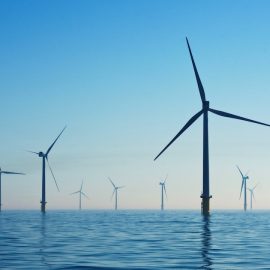

This article is an excerpt from the Shortform book guide to "How the World Really Works" by Vaclav Smil. Shortform has the world's best summaries and analyses of books you should be reading.
Like this article? Sign up for a free trial here.
How does energy work? What about food production? Manufacturing?
If you’re like most people, you don’t know the answers to these questions. How the World Really Works by Vaclav Smil explores these matters that are central to our lives but not well understood. The bottom line he wants to communicate is that the world works because of fossil fuels.
Keep reading for an overview of this book that seeks to educate us about how the world functions every day.
Overview of How the World Really Works by Vaclav Smil
The New York Times best-selling book How the World Really Works by Vaclav Smil argues that every aspect of our way of life—from the food we eat to our energy production to manufacturing—relies heavily on fossil fuels. But burning fossil fuels releases carbon dioxide and other greenhouse gasses that cause climate change.
Smil contends that neither climate pessimists (who predict imminent environmental catastrophe) nor climate optimists (who forecast instant, technological solutions) have the right idea: Rather, the answer to the problem of climate change lies somewhere in the middle. But Smil’s objective isn’t to provide solutions or predictions—it’s to help people understand how we arrived at our current dependence on fossil fuels and what that dependence looks like. He posits that we can’t engage in any intelligent discussion about how to solve the problem of climate change unless everyone—climate optimists and pessimists; liberals and conservatives—has a shared, baseline understanding of how the world works.
Vaclav Smil is a natural scientist and Distinguished Professor Emeritus in the Faculty of Environment at the University of Manitoba. He is the author of more than 40 books on topics such as energy, the environment, risk assessment, and public policy, including Numbers Don’t Lie.
We’ll explore Smil’s ideas about the functioning of four critical aspects of our world: energy, food production, manufacturing, and the environment. We’ll examine Smil’s contention that the only way to reduce our dependence on fossil fuels in each of these areas, thus slowing down climate change, is to do so gradually and at great expense.
Why We Don’t Understand How the World Works
According to Smil, most people don’t understand how the world works. This isn’t because they’re ignorant or even because knowledge is so specialized, but for three main reasons:
1. Urbanization: The majority of humans live in cities and work mostly in the service industry, so processes like the production of food, energy, and materials are largely invisible to us.
2. Automation: In addition, due to mechanization, very few people are actually involved in the processes that make our world run.
3. Glorification of data: The production of goods and energy is now seen as old-fashioned; the highest-paid and most desirable jobs are in tech and knowledge work.
To create a baseline understanding of how our world functions behind the scenes, Smil sets out to explain how energy, food production, and manufacturing all rely heavily on fossil fuels—and what that means for our environment and climate change.
How Does Energy Work?
Smil says that understanding energy is essential to understanding modern societies and economic systems. This is because we rely on energy to power our world, yet it can’t be produced from scratch—it can only be harnessed or extracted. It thus has a value far beyond what’s reflected in measurements like the price of gas.
In this section, we’ll explore the history of energy use, the advantages and disadvantages of different forms of energy, the role of fossil fuels in climate change, and Smil’s proposals for how to cut down on carbon emissions in energy production.
The History of Energy Use
Smil explains that, for centuries, the only energy sources humans relied on (besides their own labor) were fire and animals. It wasn’t until the 1900s that we began using large amounts of coal and the mid-20th century when we began relying heavily on other fossil fuels. The modern history of energy use is one of ever-increasing reliance on fossil fuels.
Fire and Muscle
Humans’ earliest source of energy was fire. Then, after the development of agriculture, domesticated animals were used for transportation, agricultural work, and lifting or carrying heavy loads. Much later, humans developed sails, waterwheels, and windmills. But even as late as the 1500s in societies that used these more modern forms of mechanical energy, the vast bulk of energy was still supplied by human and animal labor and by burning wood.
Fossil Fuels
In the 1600s, England began using coal for fuel, rather than wood. The world was slow to adopt coal as an energy source, but by 1900, coal and crude oil were providing about half of the world’s energy. In the late 1800s, new forms of mechanical energy were also developed, from water and steam turbines to gasoline-fueled combustion engines.
Commercial crude oil was first extracted in the 1850s in Russia, Canada, and the US, and was used mostly to produce kerosene. After the development of the combustion engine, it was refined to produce gasoline and diesel fuel. But crude oil didn’t become the world’s primary source of energy until giant oil fields were discovered in the Middle East and the USSR in the 1940s and 1950s.
Before WWII, the US and Canada were the only countries where many people owned cars. Mass car ownership expanded to Japan and Europe after the war. The post-war period also saw an increase in foreign travel and the use of fossil fuels in making plastics.
Fossil fuels supplied nearly 75% of energy by 1950. In the 50s, 60s, and early 70s, crude oil was so plentiful and inexpensive that there was no incentive to use it efficiently. Cheap oil was an important driver of the rapid economic expansion that took place during this time. But due to a combination of factors that included OPEC’s increase in size and power and the nationalization of various Middle Eastern oil fields, between 1973 and 1975 the price of oil rose precipitously—and the global economic growth rate dropped by 90%.
By the year 2000, only people at the bottom rung of the economic ladder (about 10% of humanity) depended on burning plant fuels, like wood and straw, for their energy.
We now use so much fossil fuel that, translated into physical labor, it’s as if every human on earth had 60 people working for them 24 hours a day, 7 days a week (and for residents of wealthy countries, this number would be closer to 200).
The Advantages and Disadvantages of Different Forms of Energy
There are many forms of energy—gravitational, heat, chemical, and radiant energy are just a few examples. Smil maintains that, because each form of energy has its own characteristics, it’s overly simplistic to believe that one form (or method of production) can always be substituted for another. Different forms of energy have different densities, different costs, and different degrees of reliability.
Crude Oil
Smil notes that liquid hydrocarbons refined from crude oil, such as gasoline, diesel fuel, and aviation kerosene, are the easiest form of energy to produce, store, and transport. This is because they are the densest type of energy: They store the most energy per unit of mass or volume. Fuel density matters for transportation because the more fuel that fits into a given space, the more room is available for passengers and cargo.
In addition to fuel for transportation, crude oil also produces non-fuel products like asphalt, plastics, and lubricants, which are necessary to reduce friction in component parts of everything from plane engines to food processing equipment.
The major disadvantage of crude oil, however, is that burning fossil fuels releases carbon dioxide and other greenhouse gasses that cause climate change.
Electricity
The primary advantages of electricity are that it’s efficient, easy to use, and clean—it doesn’t release any noxious emissions.
One key disadvantage of electricity is that it’s hard to store large amounts of it affordably. In addition, there are some aspects of modern society, such as international commercial flight, that simply can’t be powered by electricity alone. Finally, most electricity relies on fossil fuels for production. In 2020, 16% of electricity was generated by hydroelectric facilities, 7% by wind and solar, and 77% from power stations fueled mostly by coal and natural gas.
Nuclear Energy
As Smil explains, one of the major advantages of nuclear energy is that it’s very reliable. Nuclear reactors generate electricity 90-95% of the time, in contrast to offshore wind turbines, which generate electricity about 45% of the time, and solar cells in sunny climates, which produce electricity about 25% of the time. In addition, nuclear reactors can be long-lasting.
On the other hand, nuclear reactors are expensive, and due to some high-profile accidents, such as Chernobyl, the general public perceives nuclear energy as risky. Smil emphasizes that the public’s fear of nuclear power plants is based on misperception, which we’ll discuss in more detail soon.
Fossil Fuels and Climate Change
Smil says that the primary causes of climate change are:
- Fossil fuel combustion, deforestation, and cement production, which release carbon dioxide
- Cattle, natural gas production, landfills, and rice fields, which release methane
- Fertilizers, which release nitrous oxide
Carbon dioxide is responsible for about 75% of global warming, methane for 15%, and nitrous oxide for about 10%.
(Shortform note: The gasses emitted by fossil fuels—carbon dioxide, methane, and nitrous oxide—are known as greenhouse gasses. In the absence of these pollutants, sunlight and solar radiation would bounce off the Earth’s atmosphere and escape into space. However, when greenhouse gasses collect in the atmosphere, they trap the sun’s heat and cause the planet to get warmer, resulting in what’s known as the greenhouse effect. Fossil fuel use skyrocketed beginning with the Industrial Revolution of the mid-1800s, causing global temperatures to rise accordingly.)
How to Reduce Carbon Emissions
Smil argues that we need to reduce energy use in all areas—transportation, buildings, agriculture, and industry—in order to cut down on carbon emissions. Two primary ways to do so are by generating electricity from renewable sources and by using nuclear energy.
Generate Electricity Without Relying on Fossil Fuel
Generating electricity without relying on fossil fuels is the fastest way to cut down on carbon emissions because solar and wind-powered electricity is now cheaper than other forms. Countries like Germany now generate 40% of their electricity from renewable sources.
However, Smil says there are many obstacles to this approach. One challenge is constructing high-voltage lines to move renewable electricity from the place where it’s generated (such as the Great Plains for wind energy and the Southwestern US for solar) to all the places it’s needed. Another is the need for very large storage facilities for electricity. The options currently available, such as batteries and supercapacitors, aren’t big enough to serve large cities. Finally, electricity alone is not sufficient to produce steel, plastics, cement, and ammonia.
Use Nuclear Energy
Nuclear energy is another solution to cutting down on carbon emissions. People perceive the risk of living near a nuclear power plant as high in part because they have no control over the risk of an accident (as opposed to voluntary risks such as driving a car). However, Smil says that burning fossil fuels causes far more deaths from air pollution than nuclear reactors cause. He explains that even when fatalities from Chernobyl and Fukushima are included, nuclear electricity generation is far safer than generating electricity from fossil fuels.
How Does Food Production Work?
Smil says that modern methods of food production have improved the quality of life for millions of people but at the cost of burning huge quantities of fossil fuels. In this section, we’ll examine the history of food production, as well as the role fossil fuels play in fertilizers, fishing, and activities incidental to food production.
The History of Food Production
Smil explains that prior to the industrial age, food production was inefficient and unreliable, so everyone but the wealthiest elites had to worry about getting enough to eat. Since the 1800s, food production has been driven primarily by fossil fuels and electricity. Fossil fuels are used to power agricultural machinery, fertilize and irrigate crops, heat greenhouses, and transport harvests. As a result of these processes, crop yields have increased exponentially, and even though the world’s population has exploded in recent decades, the share of the population who is undernourished has decreased by 50%.
Smil discusses the role of fossil fuels in various aspects of food production:
- Fertilizers and other agrochemicals—Smil points out that the amount of fossil fuels required to produce agrochemicals is far greater than the amount required to make and power farm machinery. It takes 1.5 liters of diesel fuel to make one kilogram of nitrogenous fertilizer.
- Fishing—Fishing uses more energy than any other form of food provision.
- Incidental activities—While field farming, fishing, and aquaculture account for only about 4% of annual global energy use, total food-related energy use is close to 20%.
How to Reduce Our Dependence on Fossil Fuels in Food Production
Smil argues that it would be almost impossible to return to pre-industrial methods of food production without most people leaving the cities and spending a good portion of their time growing their own food and tending their own animals in the country. However, he says that it’s possible to reduce our modern dependence on fossil fuels in food production. He suggests three methods for doing so:
- Cutting down on food waste
- Eating less meat
- Using electricity to power agricultural machinery
How Does Our Material World Work?
Smil explains that four materials—concrete, steel, plastics, and ammonia—are used more than any others in modern society. Producing these on a mass scale requires huge amounts of fossil fuels to heat their raw materials at high temperatures. Smil claims that, aside from experimental methods, there’s currently no way to manufacture these materials without the use of fossil fuels.
Concrete and Steel
Concrete is made by heating limestone, clay, and shale in large kilns, then grinding the result into a cement powder. Concrete can withstand great pressure but not great tension. The discovery of how to reinforce concrete using steel bars solved that problem and led to reinforced concrete being used in every large building and transportation infrastructure worldwide. Reinforced concrete is used in skyscrapers, tunnels, sidewalks, runways, freeways, and dams, among other things.
Smil explains that one problem with concrete is that environmental factors such as moisture, freezing, and vibration can cause it to deteriorate. Its typical lifespan is between 20 and 100 years, depending on maintenance. Because much of the concrete in the world was installed in the second half of the twentieth century, it already needs to be replaced or destroyed—a project that will continue for decades to come.
Steel is used in bridges, foundations, ships, tools, machinery, pipelines, and weapons. It’s made using iron ore, which Smil points out is plentiful in the earth’s crust and not in danger of running out for generations. The ore is smelted in blast furnaces, then treated in oxygen furnaces. Producing steel is a very energy-intensive process.
Steel can be recycled by melting it in a massive furnace, but this is also energy-intensive: It requires the same amount of electricity per day as a city of 150,000 people. Still, wealthy countries do recycle most of their steel.
Steel and cement together are responsible for about 16% of carbon emissions.
Plastics
Most plastics are made by heating petroleum, a refined fossil fuel, at very high temperatures. Smil says that because of their low weight and high strength, plastics are ubiquitous in modern life. They’re used in cars, planes, building materials, electronics, healthcare products, clothing, and much more.
Ammonia
Smil says that ammonia is the most important material we use. While ammonia is used in explosives, dyes, fibers, and cleansers, 80% of it is used in agriculture. Smil explains that ammonia is the world’s primary source of nitrogen fertilizer and without it, nearly half of the world’s population would go unfed.
Ammonia is an inorganic compound composed of nitrogen and hydrogen. It can be found naturally in animal waste (manure) or it can be synthesized. The rapidly growing population in the early 20th century demanded a solution to the challenge of synthesizing ammonia to produce enough food for everyone. The problem, Smil explains, is that the synthesis of ammonia from its elements requires a huge amount of energy, and thus, the use of fossil fuels.
Today, wealthy countries use the vast majority of ammonia fertilizers and most of these are synthetic. Because of our life-or-death reliance on this material, Smil says, it’s one of the most difficult areas in which to reduce our use of fossil fuels.
Cutting Down on Carbon Emissions in Manufacturing
Smil says it’s unlikely that the ammonia, plastics, concrete, and steel industries will stop relying on fossil fuels anytime soon. And developing countries will need to increase their production of these materials many times over to catch up with wealthier countries. What’s more, “green” electricity, such as that generated by wind turbines and electric car batteries, relies on all of these materials and many others as well.
Nonetheless, Smil says there may be some steps we can take to cut down on the use of these materials. For example, we could use less ammonia by relying on some of the same methods as with food production: increasing food prices or eating less meat. Alternatively, we could get wealthy countries to produce less food.
How Does the Environment Work?
Smil argues that, for humans to survive, we need to make sure our actions don’t make Earth uninhabitable. In this section, we examine our effect on the environment by looking first at the history of climate change. Then, we look at how climate change affects our oxygen, water, and food supplies. Finally, we explore Smil’s contention that it’s difficult, if not impossible, to make climate predictions or meet current climate goals.
The History of Climate Change
Although the media and the world’s governments began to focus their attention on global warming in the late 1980s, Smil contends that we’ve known about the greenhouse effect and the dire consequences of increasing greenhouse gas emissions for at least 100 years. Around the turn of the 19th century, scientists calculated that a doubling of atmospheric carbon dioxide from preindustrial levels would result in significant warming—by one calculation, 4 degrees C, or 7.2 degrees F (which turned out to be fairly accurate). By 1958, scientists began measuring background concentrations of carbon dioxide in the atmosphere, and they showed constant and predictable increases over time.
How Climate Change Affects Oxygen, Water, and Food
There are many aspects of a healthy environment, but Smil focuses on three that are necessary for human life: oxygen, water, and food. Smil believes that we are in no danger of not having enough oxygen, water, or food as a result of climate change—if we eat less beef, manage water more efficiently, reduce food waste, and change our approach to growing crops. He outlines how climate change will affect each of these three substances:
- Oxygen—There is no danger of us running out of oxygen.
- Water—Climate change will cause some water scarcity, but he believes the bigger issue is the increasing demand for water as a result of a growing population.
- Food—Smil contends that we’re in no danger of running out of food as a result of climate change.
The Difficulty of Making Climate Predictions or Meeting Specific Warming Caps
Even for those with extensive experience and knowledge on the topic, Smil claims that it’s difficult, if not impossible, to make accurate predictions about global warming or meet current IPCC limits on warming.
The Challenge of Making Global Warming Predictions
Smil argues that it’s very difficult to make predictions about global warming because they rely on many layered assumptions, and world events are unpredictable.
Those who predict environmental catastrophe and those who forecast instant, technological solutions are both likely to be wrong, warns Smil, in part because complex predictions are often wrong.
The Challenge of Meeting Global Warming Caps
Because of our heavy reliance on fossil fuels, Smil claims that it’s impossible to meet the IPCC goal of no more than 1.5°C of warming by 2030 and net zero carbon emissions by 2050. He points out that, by 2020, warming had already increased two-thirds of that amount. The IPCC estimates would require us to cut global energy demand by half between 2030 and 2050, but, in the last 30 years, global energy demand has risen by 20%.
Smil notes that the IPCC goals rely on factors such as less demand for consumer goods, but not only are we consuming more and more goods with every passing year, but the IPCC target also assumes that low-income countries won’t want to increase their share of material goods. Moreover, he says that while carbon capture technology is an alternative to reducing emissions, this would require building a new transmission infrastructure to transport and store carbon, as well as dismantling the existing oil and gas infrastructure.
Smil points out that other than cutting down on the carbon involved in electricity generation, the world has been slow to end its reliance on fossil fuels. Even in a country like Germany that has worked to transition to renewable energy, fossil fuels still make up 78% of the primary energy supply; in Japan, that number is 90%. And even if the developed world significantly reduces its energy consumption, less developed countries actually need more energy to survive.
Smil concludes that there currently is no feasible way to end our dependence on fossil fuels quickly—it will have to be a gradual and expensive process.

———End of Preview———
Like what you just read? Read the rest of the world's best book summary and analysis of Vaclav Smil's "How the World Really Works" at Shortform.
Here's what you'll find in our full How the World Really Works summary:
- How modern-day life relies heavily on fossil fuels for nearly everything
- Why liberals and conservatives need to better understand how the world works
- Why it's nearly impossible to meet current IPCC limits on global warming






